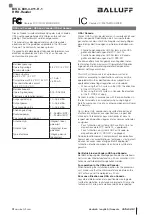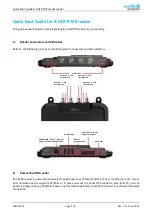
Functions
5.7 Isochronous mode
PROFINET with STEP 7
Function Manual, 05/2021, A5E03444486-AL
221
To ensure that all input data is ready for transport via the subnet at the next start of the
PROFINET IO cycle, the start of the I/O read-in cycle is advanced by the amount of lead time T
I
.
T
I
is the "flashbulb" for the inputs; at this instant, all synchronized inputs are read in. T
I
is
necessary in order to compensate for analog-to-digital conversion, backplane bus times, and
the like. The lead time T
I
can be configured by STEP 7 or by you. Let the lead time T
I
be
assigned automatically by STEP 7. With the default setting, STEP 7 ensures that a common,
minimum T
I
is set.
The subnet transports the input data to the IO controller/DP master. The application is started
synchronized to the cycle. That is, the isochronous mode interrupt OB is called after a
configurable delay time T
V
. The user program in the isochronous mode interrupt OB defines
the process response and provides the output data in time for the start of the next data cycle.
The length of the data cycle (send clock/DP cycle time) is always configured by you.
T
O
is the time for the compensation arising from the backplane bus and the digital-to-analog
conversion within the IO device/DP slave. T
O
is the "flashbulb" for the outputs. The
synchronized outputs are output at this time. Time T
O
can be configured by STEP 7 or by you.
Let time T
O
be assigned automatically by STEP 7. STEP 7 automatically calculates a common,
minimum T
O
.
5.7.4
Configuring isochronous mode
5.7.4.1
Introduction
Configuring at a glance
Setting parameters for isochronous operation of the I/O module
You use the properties of the I/O addresses of the corresponding I/O module to:
•
Set isochronous mode for the module.
•
Assign the inputs and outputs of the module to a process image partition and an
isochronous mode interrupt OB.
The data of the process image partition is updated synchronously to the assigned OB.
Isochronous mode interrupts give you the option of starting programs isochronously with
the PROFINET send clock. Isochronous mode interrupts are processed with high priority.
Setting the send clock
The send clock is the shortest possible transmission interval for the data exchange. In
isochronous mode, the send clock corresponds to data cycle T_DC.
You set the send clock in the properties of the PROFINET interface of the CPU or in the sync
domain.
Summary of Contents for SIMATIC ET 200AL
Page 2: ......
Page 143: ......
Page 218: ......
Page 250: ......
Page 296: ......
Page 337: ......
Page 365: ......
Page 392: ......
Page 419: ......
Page 451: ......
Page 483: ......
Page 597: ......
Page 648: ......
Page 702: ......
Page 739: ......
Page 781: ......
Page 804: ......
Page 828: ......
Page 853: ......
Page 880: ......
Page 906: ......
Page 996: ...Diagnostics ...
Page 1121: ......
Page 1565: ......
















































